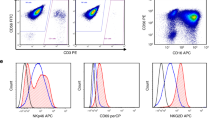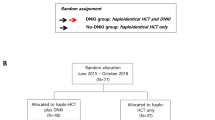Abstract
The major cause of treatment failure in hematologic malignancies is the development of resistance to chemotherapeutic agents and the presence of clonogenic tumor cells in remission bone marrow. In the present study, we tested the optimal conditions for activation by interleukin-2 (IL-2) of endogenous bone marrow effector cells to develop cytotoxicity against solid tumor and leukemia cells and the effects of IL-2 treatment on eradication of malignant cells from the marrow product while preserving hematopoiesis. Normal donor bone marrow was contaminated with 10% A549 lung cancer cells, MCF-7 breast cancer, or EM2 leukemia cells, and then combined with peripheral blood-derived lymphokine-activated killer (LAK) cells which had been incubated in the presence of IL-2, 6000 IU/ml, for 5 days. Eradication (A549 and MCF-7) or >90% reduction in tumor cell number (EM2) was achieved upon exposure of the marrow to LAK cells but not to control, non-IL-2-exposed PBMC. The non-cross-resistance of chemotherapy and cell-mediated cytotoxicity were tested by using chemoresistant target cells for LAK cytotoxicity assays. Ara-C-resistant K562 cells were sensitive to LAK cytotoxicity, similar to sensitive controls. Similar effects were seen in daunomycin-resistant HL60 leukemia cells and VP-16-resistant K562 cells. The daunomycin-resistant K562 cells were also sensitive to LAK cell killing similar to sensitive controls. Activation of bone marrow mononuclear cells (BMMC) with IL-2, 6000 IU/ml for 24 h, significantly enhanced cytotoxicity against the NK-resistant, LAK-sensitive Daudi cell line. This procedure did not result in significant loss of total BMMC or hematopoietic colony-forming units. We then studied the possibility that the effector cell activity of the IL-2-activated BMMC which is diminished after removal of the IL-2 at 24 h could be recovered upon re-exposure of the marrow to IL-2. We found that the optimum conditions for preserving cytotoxicity were prolonged continuous exposures to IL-2 but that re-exposure of the 24-h IL-2-activated BMMC to IL-2 after a 1- or 2-week IL-2 withdrawal was associated with full recovery of cytotoxicity. These experiments also demonstrated that the overall recovery of viable cells from the BMMC was over 100%, possibly due to a proliferative effect of the IL-2 exposure on BMMC. These results demonstrate that the use of IL-2-activated marrow in patients with acute leukemia in remission undergoing autologous bone marrow transplantation (aBMT) may overcome the obstacles of clonogenic, drug-resistant minimal residual disease. The effector cell activity and hematopoietic capacity of the activated bone marrow product can also be maintained even if optimal clinical care requires an interruption in the in vivo exposure to IL-2. This therapeutic approach is currently being tested in acute leukemia patients undergoing IL-2-activated aBMT followed by prolonged IL-2 treatment before and after hematologic reconstitution.
This is a preview of subscription content, access via your institution
Access options
Subscribe to this journal
Receive 12 print issues and online access
$259.00 per year
only $21.58 per issue
Buy this article
- Purchase on Springer Link
- Instant access to full article PDF
Prices may be subject to local taxes which are calculated during checkout
Similar content being viewed by others
Author information
Authors and Affiliations
Rights and permissions
About this article
Cite this article
Margolin, K., Wright, C. & Forman, S. Autologous bone marrow purging by in situ IL-2 activation of endogenous killer cells. Leukemia 11, 723–728 (1997). https://doi.org/10.1038/sj.leu.2400646
Received:
Accepted:
Issue Date:
DOI: https://doi.org/10.1038/sj.leu.2400646
Keywords
This article is cited by
-
Anti-tumor effects of CIK combined with oxaliplatin in human oxaliplatin-resistant gastric cancer cells in vivo and in vitro
Journal of Experimental & Clinical Cancer Research (2010)
-
IL-2 in the therapy of melanoma and other malignancies
Medical Oncology (2009)
-
Transplantation of IL-2-mobilized autologous peripheral blood progenitor cells for adults with acute myelogenous leukemia in first remission
Leukemia (2001)



